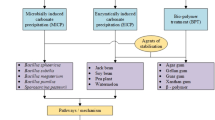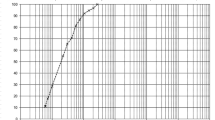Abstract
As quality soils become scarce and their location is more difficult and expensive, it becomes increasingly necessary to improve soil quality through soil stabilization. The benefits of energy saving and resource conservation, effective recycling of all solid wastes (fly ash, slag, lime, marble dust, etc.) has become a global concern that requires research and development. This article presents the results of a laboratory tests to investigate the effects of marble powder and lime on compaction characteristics, Atterberg limits, shear strength parameters, and unconfined compression test of two Algerian soils. Marble powder and lime are added in varying percentages (2%, 4%, and 6% by weight) to the soil samples. Test results reveal that the liquid limit and plasticity index decrease, whereas the plastic limit increases with the addition of lime and marble powder for soil A and soil B, in which the decrease is more significant with soil A than soil B. The unconfined compressive strength increased with increasing curing time and percentages of lime and marble powder for the two soils. The highest unconfined compressive strength was achieved at 6% marble powder for soil B after 28 days. The addition of marble powder for both soils decreased the optimum moisture content and increased the corresponding maximum dry unit weight. However with lime addition, both soils show decrease in the optimum moisture content and in the corresponding maximum dry unit weight. The shear strength parameters increased for both soils with increase of lime percentages. Whereas for the addition of marble powder, there is an increase of friction angle and decrease of cohesion for soil A. There is considerable change for soil B with marble powder, a decrease in friction angle and an increase in cohesion. The results show that marble powder could be used as a stabilizer for soils with high clay content and known mineralogy composition. In addition, it is very important to get rid of its negative effect on environment and to obtain economical benefit from it.
























Similar content being viewed by others
References
Ayininuola GM, Agbede OA, Franklin SO (2009) Influence of calcium sulphate on subsoil cohesion and angle of friction. J Appl Sci Res 5(3):297–304
Attoh-Okine NO (1995) Lime treatment of laterite soils and gravels-revisited. Constr Build Mater 9(5):283–287
Azadegan O, Jafari SH, Li J (2012) Compaction characteristics and mechanical properties of lime/cement treated granular soils. Electron J Geotech Eng 17:2275–2284
Bell F (1996) Lime stabilization of clay minerals and soils. Eng Geol 42(4):223–237
Cai Y, Shi B, Ng CWW, Tang C (2006) Effect of polypropylene fiber and lime admixture on engineering properties of clayey soil. Eng Geol 87:230–240
Chittoori BCS (2008) Clay mineralogy effects on long-term performance of chemically treated expansive clays, Doctoral dissertation, The University of Texas at Arlington
Dash SK, Hussain M (2012) Lime stabilization of soils: reappraisal. J Mater Civ Eng 24:707–714
Fang HU (1991) Foundation engineering handbook. Van Nostrand Reinhold, New York
Holtz W (1969) Volume change in expansive clay soils and control by lime treatment. In: Proceeding of 2nd international research and engineering conference on expansive clay soils, pp 157–174
Kinuthia JM, Wild S, Jones GI (1999) Effects of monovalent and divalent metal sulphates on consistency and compaction of lime-stabilised kaolinite. Appl Clay Sci 14(1–3):27–45
Little DN, Scullion T, Kola PBVS, Bhuiyan J (1995) Guidelines for mixture design and thickness design for stabilize bases and subgrades. Texas A and M university, Austin, Texas
Mallela J, Harold Von Quintus P, Smith KL, Consultants E (2004) Consideration of lime stabilized layers in mechanistic-empirical pavement design. The National Lime Association, Arlington, Virginia, USA
Negi AS, Faizan M, Siddharth DP, Singh R (2013) Soil stabilization using lime. Int J Innov Res Sci Eng Technol 2(3):448–453
Nelson JD, Miller DJ (1992) Expansive soils—problems and practice in foundation and pavement engineering: and D. J., Department of civil engineering, Colorado state university, Wiley, New York, 259 pp
Pappu A, Saxena M, Asolekar SR (2007) Solid wastes generation in india and their recycling potential in building materials. Build Environ 42:2311–2320
Parsons RL, Johnson CP, Cross SA (2001) Evaluation of soil modification mixing procedures. In: Proceeding of 80th Annual Meeting, Transportation Research Board. National Research Council, Washington, D.C
Ramadas T, Kumar ND, Yesuratnam G (2011) Geotechnical characteristics of three expansive soils treated with lime and fly ash. Int J Earth Sci Eng 4:46–49
Saygili A (2015) Use of waste marble dust for stabilization of clayey soil. Mater Sci (Medziagotyra) 21(4):601–606
Talaha A, Kharchia F, Chaid R (2015) Influence of marble powder on high performance concrete behavior. Procedia Eng 114:685–690
Terrei R, Epps J, Barenberg E, Mitchell J, Thompson M (1984) Soil stabilization in pavement structures-a user's manual, vol 2. Moisture design consideration, Federal Highway Administration, Washington, DC
Wilkinson A, Haque A, Kodikara J, Adamson J, Christie D (2010) Improvement of problematic soils by lime slurry pressure injection: case study. J Geotech Geoenviron Eng 136:1459–1468
Acknowledgements
Thanks go to Prof. Dr. Alaa Mustafa Professor of sedimentary rocks, Geology Department, Faculty of Science, Al-Azhar University (Assiut Branch), for his critical review of the original manuscript and constructive suggestions for upgrading the clarity of the manuscript. The authors are also greatly indebted to the editor of Geotechnical and Geological ngineering journal and the reviewers for their valuable time and the comments they raised that have improved the rigor of the work.
Author information
Authors and Affiliations
Corresponding author
Additional information
Publisher's Note
Springer Nature remains neutral with regard to jurisdictional claims in published maps and institutional affiliations.
Rights and permissions
About this article
Cite this article
Rouaiguia, A., El Aal, A.K.A. Enhancement of the Geotechnical Properties of Soils Using Marble and Lime Powders, Guelma City, Algeria. Geotech Geol Eng 38, 5649–5665 (2020). https://doi.org/10.1007/s10706-020-01368-5
Received:
Accepted:
Published:
Issue Date:
DOI: https://doi.org/10.1007/s10706-020-01368-5




